LG OLED55C9 Review
LG OLED55C9 Review
A super-smart and feature-packed 4K OLED TV from LG
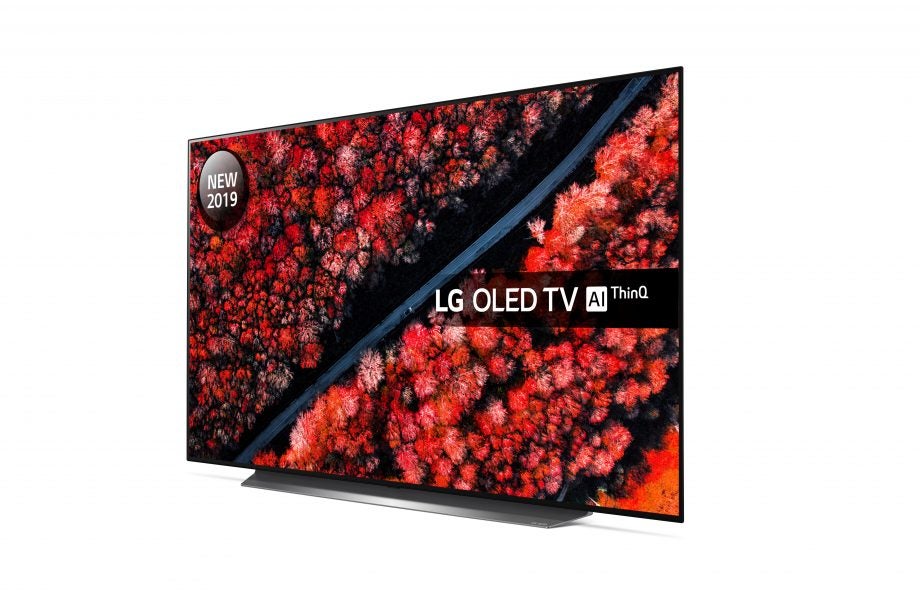
Verdict
This state-of-the-art OLED TV delivers AI enhancements, a comprehensive smart platform, alongside superb pictures and sound
Pros
- Impressive image accuracy
- Amazing blacks and contrast
- AI-enhanced smart platform
- Dolby Vision and Atmos
- Incredibly low input lag
Cons
- Limited HDR brightness
- No HDR10+ support
Key Specifications
- Review Price: £2499
- 4K Ultra HD resolution
- HDR10, Dolby Vision and HLG
- webOS with ThinQ AI
- 4 x HDMI 2.1
- W1228 x H738 x D251mm
- Weight: 23kg
The LG C9 (OLED55C9, OLED65C9) is no longer available to purchase from most online retailers (though you can try your luck on websites such as eBay). It has been replaced by the 2020 LG CX, which offers even better performance and a number of new features over the C9.
Original review as follows.
The LG OLED55C9 is the latest mid-range 4K OLED TV from the manufacturer. It includes the Alpha 9 processor not found in the entry-level B9, but eschews the expensive cosmetic enhancements found on models further up the range, making it something of a sweet spot in terms of performance and price.
The 2nd-generation Alpha 9 processor isn’t the only new feature in the C9; there’s also improved sound quality and webOS 4.5 with its snazzy new user interface. The inclusion of artificial intelligence promises the smartest OLED yet, and the use of HDMI 2.1 connections ensures this TV will remain future-proof for years to come.
The range consists of the 55-inch OLED55C9PLA (£2499), 65-inch OLED65C9PLA (£3299) and 77-inch OLED77C9PLA (£7499).
Related: Best TVs
LG OLED55C9 – Design
The LG OLED55C9 boasts a super-slim OLED panel with a black trim around the outer edge and no real bezel. The TV is mere millimetres wide at the top, but even at the bottom where the speakers, electronics and connections are housed it’s less than 5cm deep.
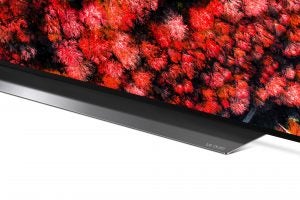
The stand looks similar to last year’s C8, with a design that fires sound directly at the viewer. It’s weighted at the rear to provide balance and support. The back panel is finished in a dark brushed metal, and the overall look is minimalist, sleek and stylish.
This year LG has added HDMI 2.1, and it’s the only manufacturer to support the new standard on its 4K TVs. Other manufacturers claim that you can deliver the same features using HDMI 2.0b, but even if that’s true, LG’s new TVs are bulletproof when it comes to any future developments.
Related: What is HDMI 2.1?
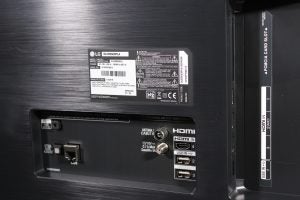
The reason for this future-proofing is HDMI 2.1’s ability to handle an incredible 48Gbps, allowing it to support higher frame rates up to 120Hz, dynamic metadata for HDR, eARC (enhanced audio return channel), variable refresh rates (VRR), and an auto low-latency mode (ALLM).
In addition to the four HDMI inputs, there are three USB ports, terrestrial and satellite tuners, a LAN port, a CI slot, an optical digital output, and a line-out that doubles as a headphone jack. In terms of wireless support there’s built-in Wi-Fi (802.11ac), Bluetooth (5.0) and AirPlay 2.
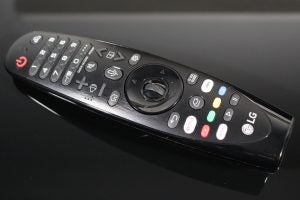
The latest version of the Magic Remote remains a masterpiece of ergonomic design. It’s comfortable to hold and intuitive to use, thanks to its on-screen pointer. There’s a built-in microphone for voice control, and dedicated buttons for Netflix, Amazon, and Rakuten TV.
Related: How to find 4K HDR content on Netflix and Amazon Prime Video
LG OLED55C9 – Features
The LG OLED55C9 is very much an evolution of the company’s previous OLED TVs, with the same 4K (3840 x 2160) 10-bit panel as last year. However, it also accepts a 12-bit signal and supports 4K frame rates up to 120Hz. The panel can deliver 100% of the DCI-P3 wider colour gamut, and in testing it produced a peak brightness of 780 nits on a 10% window.
The 2nd-generation Alpha 9 processor employs deep-learning AI algorithms that analyse a database composed of millions of images. As a result of this analysis it then optimises the picture depending on the type and quality of content. The processing can even recognise specific content, and then optimise the image accordingly.
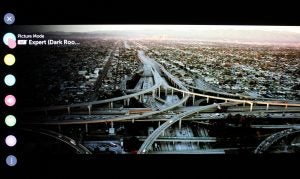
As part of this optimisation process the Alpha 9 upscales lower-resolution content, applies noise reduction where necessary, and enhances the sharpness to bring out more detail. The new AI Brightness feature uses a sensor to detect ambient light, and then optimises the brightness based on the specific viewing environment to improve the visibility in dark areas of the picture.
As with previous LG OLEDs, the C9 supports a number of different versions of HDR, specifically HDR10, broadcast HLG, and Dolby Vision. However, it doesn’t support HDR10+, presumably because this form of HDR with dynamic metadata is primarily associated with arch-rival Samsung. Unfortunately, this does put the C9 at a disadvantage to competing OLEDs from Panasonic and Philips.
Related: Netflix vs Amazon Video
LG OLED55C9 – Smart platform
The LG OLED55C9 sports the latest generation of webOS, which now includes a second tier on the launcher bar. This useful addition makes it easier to access content, with the AI-enhanced Preview feature makes recommendations based on your viewing habits.
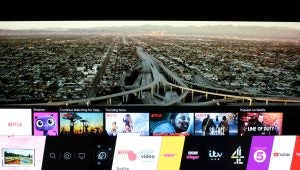
LG has always included a comprehensive selection of apps on its TVs, and that trend continues. The C9 has just about every streaming service imaginable including Netflix, Amazon, YouTube, Now TV, Rakuten, and all the UK TV catch-up services.
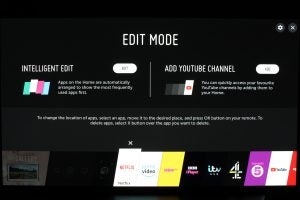
Thankfully, the Intelligent Edit feature lists your apps based on how often you use them, making it easier to find what you want amongst all that choice. In addition, the recommendation feature monitors and analyses your viewing habits based not only on content but also the time of day, allowing it to accommodate both children and adults.
LG has revised the Home Dashboard so that it now includes all connected mobile devices, inputs and home IoT (Internet of Things) devices in a single hub. This allows you to monitor and control any connected device in your smart home. LG will also be adding support for Apple’s HomeKit later this year.
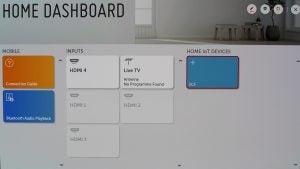
LG’s ThinQ open AI platform has been updated so that it not only includes Google Assistant but, thanks to a firmware update, Amazon Alexa as well. At the time of testing, Alexa wasn’t available but Google worked very well, allowing us to control the TV with our voice and use it as a smart assistant.
If you own an LG smartphone then you can use it to set up the C9, and the TV is able to auto-detect devices connected via HDMI. There’s a new TV channel banner, a mini-browser, and an expanded Gallery mode with seasonally curated images thanks to TripAdvisor.
Related: Best streaming sites
LG OLED55C9 – Picture performance
The LG OLED55C9 builds on the performance of previous OLED generations, delivering a stunning picture with SDR content. Blacks are deep and solid, and the self-emissive nature of OLED ensures that brighter details are produced with exacting precision.
The colours are natural and the overall image has a pleasingly accurate appearance. The TV ships in the Standard mode, and this delivers bright and colourful images that really pop. However, those who prefer a picture that adheres to the industry standards can also choose one of the two ISF modes.
The 2nd-gen Alpha 9 processor certainly plays its part, upscaling lower-resolution images to ensure every pixel in the 4K panel is used to its full potential. The AI machine learning also helps, eliminating unwanted noise and enhancing the images.
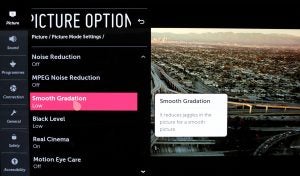
The overall picture is clean and free of unwanted artefacts and banding. LG’s 2018 OLEDs had issues with macro-blocking in the dark parts of the image and brightness flashing, but none of these problems are apparent on the C9, suggesting they’ve been addressed.
LG introduced de-contouring in 2018, but it wasn’t a standalone feature, instead being combined with noise reduction. This year, there’s a separate Smooth Gradation control for those who want to eliminate any banding – and it proved very effective in testing.
The Motion Pro black frame insertion feature was also introduced last year. This has now been revised, improving motion handling with less flicker. The motion handling in general was reasonable, but using the frame interpolation can make film-based content look more like video.
The input lag is a blink-and-you’ll-miss-it 12.7ms, which is remarkably low and sure to please gamers. The inclusion of HDMI 2.1 and its support for VRR and ALLM will also guarantees a superior gaming experience, and image retention shouldn’t be an issue thanks to LG’s protective measures.
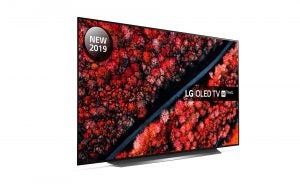
The C9 isn’t just a great TV with SDR content, it’s equally as impressive when it comes to HDR. An OLED panel isn’t as bright as an LCD TV, but dynamic range is about more than just nit values. The absolute blacks and pixel-precise highlights ensure that HDR retains plenty of impact.
The HDR colours are also excellent, delivering all of the DCI-P3 colour space and doing so with exceptional accuracy. The resulting HDR images have deeply saturated colours that appear more natural and nuanced, especially when combined with the superior contrast ratios.
Tone mapping also proved extremely accurate in testing, with Dynamic Tone Mapping mode highly effective at addressing the brightness limitations of OLED. This feature analyses HDR on a frame-by-frame basis, adjusting the tone mapping accordingly, thus improving the experience.
The C9 also supports Dolby Vision, which uses dynamic metadata (not to be confused with dynamic tone mapping) to deliver subtle improvements in the HDR performance. Dolby Vision is available on Netflix, Amazon, iTunes, and 4K Ultra HD Blu-ray.
However, LG doesn’t currently support HDR10+, which is another version of HDR using dynamic metadata. A number of manufacturers, including Panasonic and Philips, now support both formats, and there’s a danger that LG could find itself the only hold-out when it comes to HDR10+ (in much the same way that Samsung is the only manufacturer not supporting Dolby Vision). The two competing formats are gaining traction in the marketplace, so it makes sense for TV manufacturers to support both and thus ensure consumers don’t miss out.
Related: Best TV deals
LG OLED55C9 – Audio performance
The LG OLED55C9 benefits from advances in audio reproduction that allow this incredibly slim TV to deliver an impressive level of sound quality. In part this is due to the TV’s ability to optimise its acoustic performance based on the specific characteristics of the room using the One Touch Sound Tuning feature.
This utilises the mic in the remote to analyse the room’s acoustical signature from the main listening position, and then set-up the TV accordingly. Before saving the settings, the AI acoustic tuning allows you to compare the sound before and after optimisation. There’s also a choice of modes: Standard, Bass Boost, and Treble Boost.
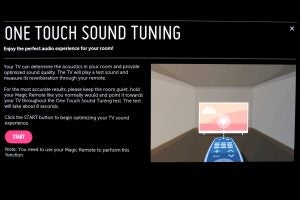
Thanks to this acoustic tuning and the clever stand design that fires the audio towards the viewer, sound quality is excellent. The C9 creates a wide front soundstage that retains plenty of detail and crisp clarity. The dialogue is clear and focused, while music spreads out from either side. Effects sound clear and precise, and there’s a decent amount of bass.
A new AI Sound mode uses psychoacoustic processing to up-mix 2.1-channel audio to virtual 5.1 surround sound. This kind of audio trickery fools the ear into thinking the sound has a more open sense of staging that resonates around the room. This feature does create the illusion of greater surround presence – but, thankfully, dialogue remains prioritised on the screen.
If all this AI-enhanced acoustic wizardry isn’t enough, the C9 also supports Dolby Atmos. This allows the TV to decode the discreet channels encoded in Atmos content and render a more immersive experience. Obviously, it can’t fully replicate a genuine multi-channel speaker setup, but the use of psychoacoustics results in a more open sound, with a greater sense of envelopment.
Related: Best soundbars
Why buy the LG OLED55C9?
The LG OLED55C9 is the perfect evolution of what has come before, refining the overall performance rather than trying to rewrite the rule book. This OLED 4K TV builds on the technology’s strengths, while adding AI-enhanced picture processing that delivers superb SDR and HDR images.
An OLED panel might not be as bright as an LCD TV, but the superior blacks and pixel-level precision more than make up for that. An impressively accurate image and deeply saturated colours ensure that the C9 is capable of remarkable levels of picture performance.
The inclusion of HDMI 2.1 ensures this TV will remain future-proof for years to come, and overall it’s feature-packed – aside from the absence of HDR10+. Gamers will be delighted at an input lag of less than 13ms, and the AI-enhanced audio is impressive, too.
A comprehensive set of streaming services is delivered by the highly intuitive webOS system that now benefits from the inclusion of both Google Assistant and Amazon Alexa. There are also AI-powered recommendations, and a new Home Dashboard that turns your TV into a digital hub.
The LG C9 is one of the smartest OLED TVs that money can buy, but there will still be plenty of competition this year. In particular from the Panasonic GZ1000 and Philips 804, both of which will include Dolby Vision and HDR10+, thus supporting both versions of dynamic metadata HDR.
Verdict
This state-of-the-art 4K OLED TV delivers AI-enhanced picture and sound, and a smart platform that’s as comprehensive as it is clever. The SDR and HDR images are both superb, and it’s only the lack of HDR10+ support that disappoints.
How we test televisions
We test every TV we review thoroughly over an extended period of time. We use industry standard tests to compare features properly. We’ll always tell you what we find. We never, ever, accept money to review a product.


